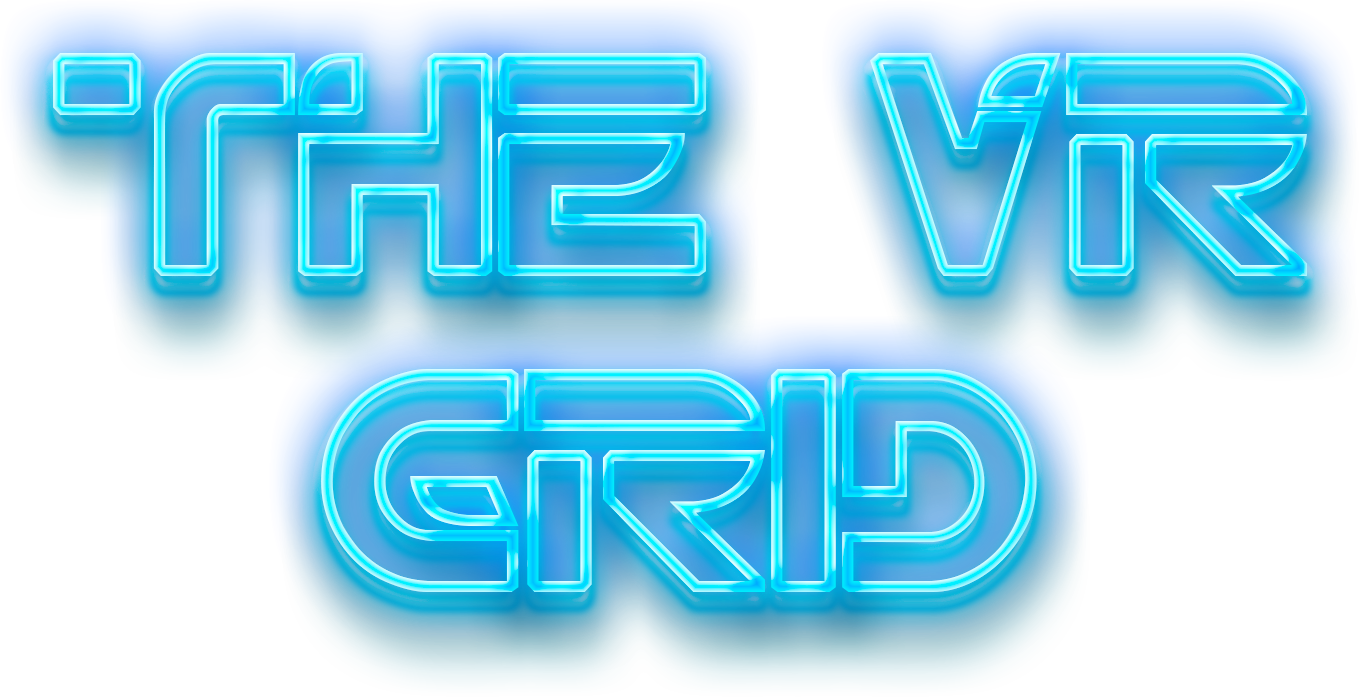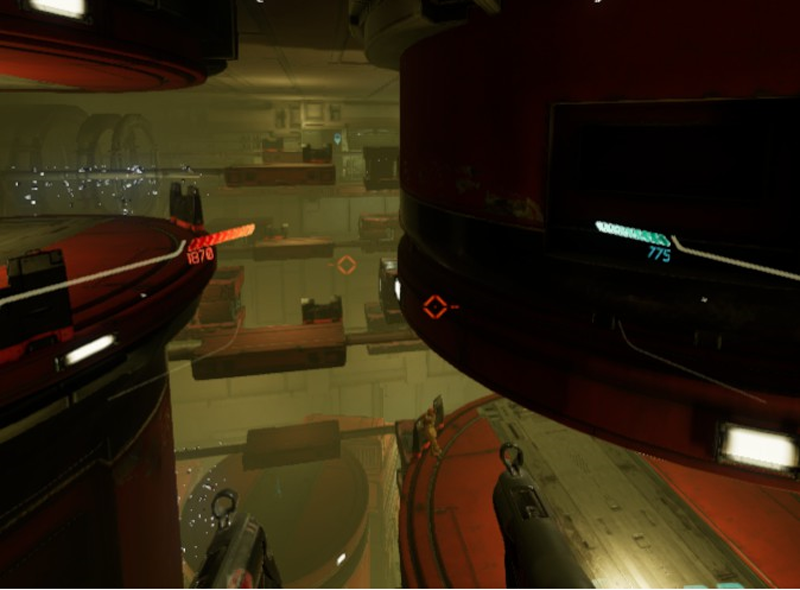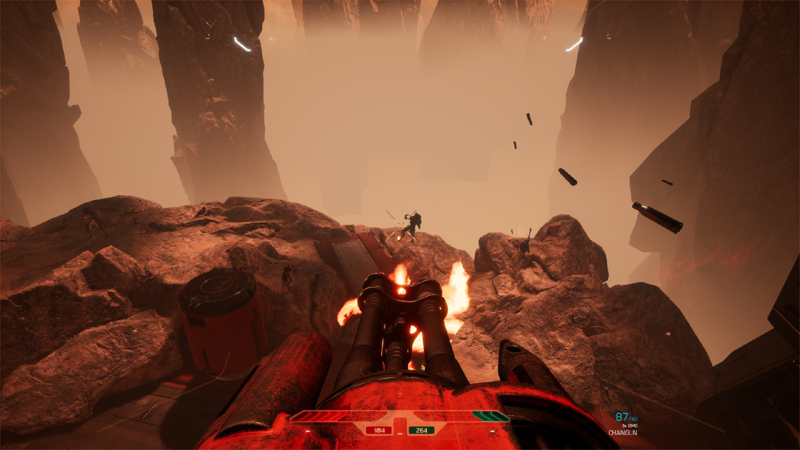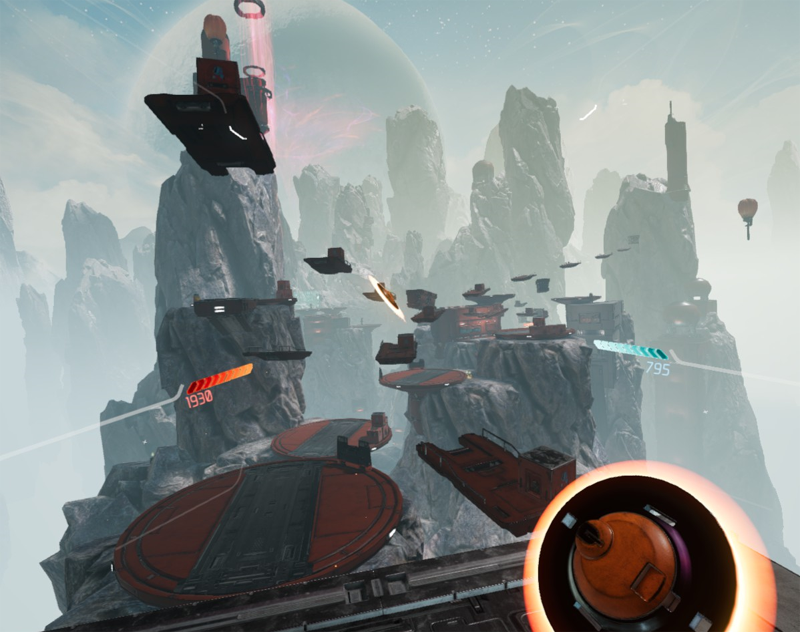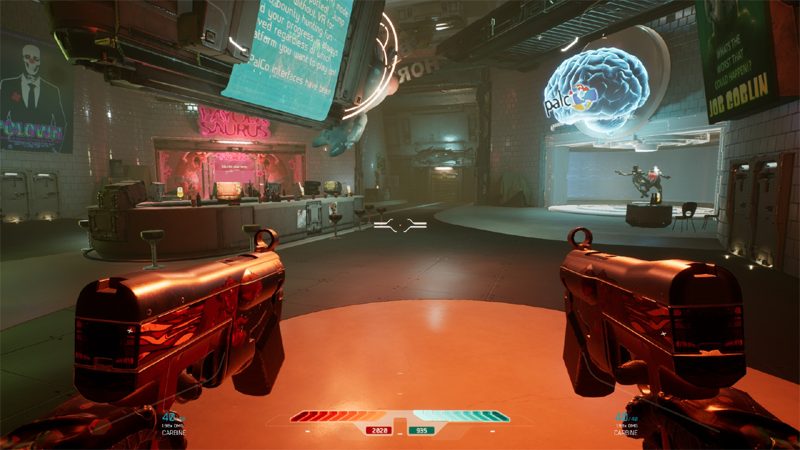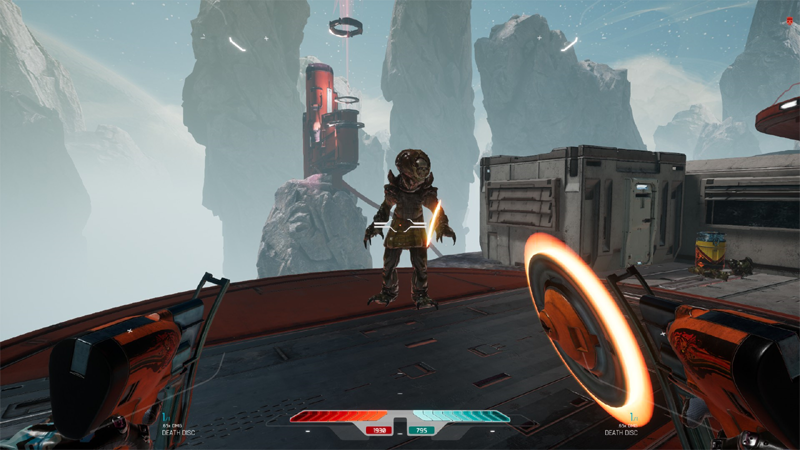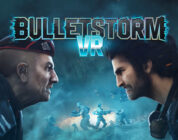Developer / Publisher – Drifter Entertainment
Price – US $29.99 / EU €27.99 / UK £23.79
Release Date – June 04, 2018
Input – Tracked Motion Controllers
Play Area – Sitting, Standing, Roomscale
Store – Steam
Reviewed on – HTC Vive
Gunheart is a co-op focused, sci-fi action-adventure game. In the future, certain privileged mercenaries are, upon an untimely death, brought back to life by the Palco corporation: a ruthless agency that holds an apparent monopoly on intergalactic colonization. These lucky few, indebted to Palco, are hired to work off their reincarnation payments by fighting as bounty hunters for the corporation. This scenario sets the stage for an open-ended variety of missions throughout “Planet Fortune,” a sprawling desert world invaded by alien “anthromites.” Gunheart is a high-quality title that I frequently return to, with addictive and fast-paced gameplay that stays fresh for a long time.
The main objective in Gunheart is simply to kill all the enemies, collect loot, and reach the end of the level. Sometimes, this is broken up by boss battles and survival sequences. Although this general gameplay is simple, it’s filled with nuances and variety that add plenty of uniqueness and replayability.
Holding down the grip buttons in either hand conjures a multi-tool, which can be used to pick up any object and launched at high velocity at a target. This device works similarly to the “gravity gun” in Half Life 2 and can be used to launch any object at enemies, such as the environment’s many explosive barrels. You can even pick up enemies- It’s hard to express the satisfaction I get from launching a sniper off a cliff and watching him flail his arms, yelling, as he falls into the void. Launching items is often glitchy, with them lagging in mid-air. Still, although it’s a small aspect of gameplay, it’s one of many unique game mechanics that makes Gunheart so much fun.
Gunheart has six standard weapons, which includes classics such as pistols and shotguns, as well as more unique options such as mini-crossbows and plasma-buzz-saws. Each weapon yields a completely different gameplay style, and you can dual-wield any combination of weapons you’d like, allowing for a nice variety in combat. Still, it feels like there could and should have been more weapons. This game makes up for your otherwise-meager arsenal by providing four different “combo weapons,” which can be conjured at any point by putting both controllers together. These are especially powerful and have limited ammo whereas standard weapons do not. Combo weapons, including the minigun, rocket launcher, bow, and sniper rifle, add an additional layer of depth and player choice to the combat. Having to connect your hands to equip them adds a subtle, yet satisfying physicality to gameplay.
To further enhance the amount of variety in weapons, Gunheart has a relics system. Relics of varying rarity and effectiveness can be found in loot boxes, which I’ll come back to later. Some relics can dramatically alter the way your weapon handles, and make it feel like an entirely new gun. There are practically endless weapon-relic combinations, with extra relic slots available in exchange for in-game currency. Different weapons react in different ways to various relics, and customizing your favorite weapons to be as powerful as possible is an effective gameplay strategy. You can add a smart-scope to your minigun, holographic sights to your pistols, and insta-gib to your shotgun, just to name a few examples.
These are some of the less-common relics, however. Unfortunately, Gunheart falls victim to the same issues as other games with relic systems. During your time playing, most of the relics you find will be simple stat-modifiers. These include options such as increased damage at the cost of decreased range, increased accuracy at the cost of smaller ammo magazines, and so on. Most of these really aren’t special or unique at all, and their presence feels like it serves mainly to ramp up the perceived value of the less-common, more interesting relics. Having the wrong relic on a weapon puts it at a noticeable disadvantage in combat. This means that frequent, careful micromanaging of your relics and weapons is a crucial task. Although this system adds variety to the weapons, it can get irritating to worry about whether my weapons are less effective than they could be. To its credit, this system increases the game’s replay value. Still, it often feels like an out-of-place RPG mechanic given its presence in an action first-person shooter like Gunheart.
The main issue with Gunheart’s relic system is that it holds such importance despite being such a subtle aspect of gameplay. For most of your time playing, you’ll be blasting grotesque alien anthromites. These enemies come in a wide variety, with wildly different attack behaviors. This diversifies combat, forcing you to jump between different vantage points and using your combo weapons as appropriate. Enemies react in a believable way to each of your weapons, with smart AI that adds difficulty and prevents gameplay from getting boring. The gunplay has a major issue, however. Although weapons such as the pistols and buzz-saws are every bit as hefty-feeling and satisfying as they should be, this isn’t the case for all your firearms.
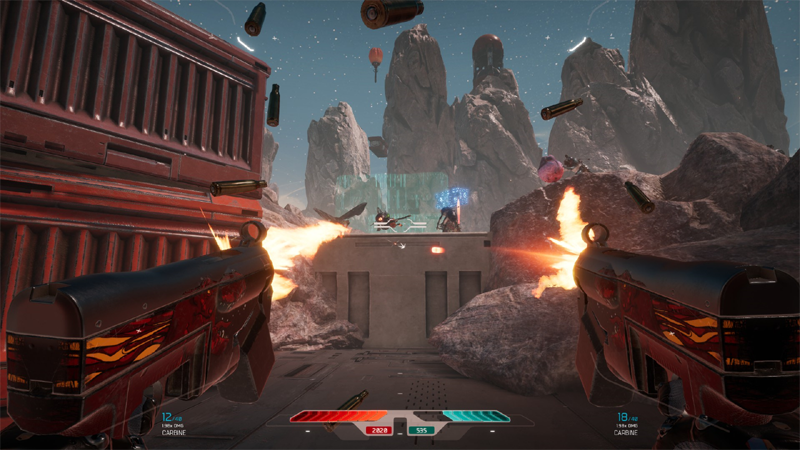
Even though my SMGs have been upgraded with the finest of relics, they still feel weak and unsatisfying
Some of your options feel like incredibly weak pea-shooters that provide no satisfaction. Even when you’re mowing down whole crowds of anthromites, watching them crumble into piles of bloodied limbs, your guns can feel as weak as a Nerf gun shooting at a piece of styrofoam. The worst offender, in my opinion, is the game’s submachine guns. These are arguably the most versatile weapons in the game but using them just doesn’t feel satisfying. Shotguns have a similar issue, although they can be improved in this sense by installing the right relics. Although this isn’t a problem with all weapons, I would consider this the most serious issue with Gunheart in general. This is a shooting-focused game, after all; every weapon should feel powerful enough to make combat satisfying, with or without relics. The game makes up for this somewhat by having subtle hit markers and an associated sound, but this doesn’t do quite enough to mitigate the issue. I found myself choosing between having a satisfying experience or a varied one: The only weapons designed in a perfectly satisfying way are the pistols, buzz-saws, and sniper rifle- a solid setup for a couple levels, but not quite enough to maintain the diverse combat that Gunheart is best for.
Putting combat aside, another unique and important gameplay feature in Gunheart is movement. While both teleportation and trackpad movement options are available, I would recommend keeping both enabled. This is an extremely fast-paced game. If you aren’t prepared to sprint across the battlefield in a matter of seconds, you’ll be dead before you even know what happened. Trackpad movement is fast- so fast that it can almost get annoying. However, it’s helpful for running between cover locations and scouting out the area. You can also double-jump, making this game’s pacing akin to arena shooters such as Quake.
While you can use trackpad movement to navigate the terrain very quickly, teleportation is not just a crutch for those who suffer from motion sickness- it acts as a fun gameplay mechanic akin to the ‘blink’ power in Dishonored. You can teleport instantly to surprisingly distant locations, including platforms that are far above or below you. With this game’s environment design, gameplay has an intensely vertical aspect. The player is given a huge amount of freedom to navigate the environment as they please. Using both teleportation and free locomotion, I had almost as much fun wandering around the map as I had actually shooting anthromites. Jumping off the side of a cliff, fleeing an enemy ambush, then teleporting mid-fall to a ledge for safety, is a thrilling feeling that I haven’t experienced in any VR game other than Sairento. The only problem with movement in Gunheart is that some moving platforms in the environment, clearly designed with teleportation in mind, cause your free locomotion to stop working while standing on it. This makes movement feel glitchy and frustrating for a while, but once you get familiar with which platforms can be navigated with what level of ease, it stops being a major problem.
The fast-paced movement in Gunheart is fun in part thanks to its environmental design. Most viewable aspects of the environment can be traversed thanks to Gunheart’s vertical movement, giving the maps a certain open-world flair, even though each mission is entirely linear. The maps are massive, sprawling, desert environments comparable to those in Borderlands. The architecture of every building, bridge, and cliffside is massive, and the game’s set pieces are utterly awe-inspiring. I’ve taken breaks from combat many times just to gaze at the scenery. In turn, the graphics in Gunheart are absolutely amazing. Textures, light rays, and anisotropic filtering are all top-notch, and with a hint of increased supersampling, this game has some of the highest visual fidelity of any VR title I’ve played to date. For this reason, however, the game is extremely demanding on your hardware, and you should make sure your PC fits the bill before picking it up.
Gunheart is a game that takes its user interface very seriously. In between missions, take a load off at the “Bent Horizon,” Palco’s sports pub for mercenaries preparing for their next assignment. Here, you can upgrade your gear, customize weapons, open loot-boxes, learn about the anthromites, socialize with other players, and select new missions. In-game currency can be spent on a variety of things, such as a variety of cosmetic options on your character. Cosmetics aren’t that exciting, only yielding very subtle changes to your appearance, but this is still a decent feature. You can also upgrade your damage, armor, and shielding for an increasingly-high price, in lieu of a levelling-up system. Your heads-up display isn’t particularly intrusive, although the crosshairs on weapons like the SMGs are a bit obnoxiously large. I should also mention the “game over” death screen, which feels about as brutal as it gets. The developers actually released a video discussing the hard work they put specifically into improving the death screen, and it shows.
When you find hidden prizes or complete challenge objectives while on a mission, loot crates spawn as literal Easter eggs and piggy banks at the Bent Horizon. You can smash these open, using baseball bats, to reveal the precious cash and relics within. This is a fun and interactive way to open loot. I also have to commend the developers for not embedding any monetization schemes into this system. Despite setting the stage perfectly for unethical microtransactions, there are no such greedy business practices in Gunheart. Everything uses in-game currency, and loot boxes are earned entirely in-game.
You can also find a weapon station in the Bent Horizon, where guns can be purchased and relics can be installed. Here, you can also go to the most fun firing range I’ve experienced in a game. Whereas most games interpret the concept of a “firing range” as an empty wall at which you can test out your guns, Gunheart goes a step further. This firing range, taking place in a large warehouse, sends rows of harmless, holographic enemies along rows at varying distances. Gameplay here is reminiscent of Space Invaders, and this stands as a fun and addictive game mode separate from the base game. There are plenty of other fun and semi-hidden secrets in Gunheart, such as a menu option that allows you to wield a balloon-blowing device or a cube-drawing tool. Entertaining tid-bits of game design such as these are fun little additions, and seem to reflect on the vision of early VR experiences such as The Lab.
Although Gunheart can be played entirely single-player, it’s designed as a cooperative experience. Several players can come together to fight the anthromites, with horde size and difficulty increasing with each additional player. Players incapacitated in combat can be revived by teammates, which adds a hectic component to gameplay. The experience works very well in co-op, with a social aspect comparable to that in Left 4 Dead. By default, single-player games are launched as open servers that any player can join as a co-op partner via a server browser. While it may sound irritating to have unwelcome players join your game, this is a crucial feature. Very few multiplayer VR games have more than a small handful of players, but thankfully, Gunheart has a large and thriving community. Paired with the open-server single player feature, it’s rare that you won’t find a partner to blast aliens with. This is also thanks to cross-compatibility between the Rift, Vive, Windows Mixed Reality, and even non-VR (which I’ll get back to later), further increasing this game’s player-base. This game also has a fun and fast-paced PvP deathmatch mode, which feels modeled after games like Unreal Tournament. Unlike campaign-based co-op, however, there are rarely players in PvP deathmatch.
The content value of Gunheart is exceptional. I have played for 12 hours so far, and I intend to play much more. The main campaign, following a specific storyline where you must save Planet Fortune from total annihilation, is the game’s main component. While the story itself is weak, it sets an appropriate stage for all the game’s other levels. There are side-missions in which you must defend money-pumps from anthromites as they churn out cash, serving as a typical wave-defense shooter. There are levels where the objective is generally to clear out anthromites from the map, which are typical missions but without any storyline. There are also levels that are procedurally generated and especially-difficult, which theoretically adds a ton of replayability- however, they hardly seem to change each time, calling the allegedly procedurally-generated environments into question. Every mission also has a handful of challenge options, such as setting a speed-run or beating it without dying, which increases your score and awards you bonus cash. This encourages the player to play levels over, striving for an ever-higher score, adding even more replayability.
Gunheart also has weekly missions, which are updated into the game every week. These are usually much harder than any other missions and require a team of players in cooperative mode to even stand a fighting chance. The presence of these missions, changing each week, ensures that the game will technically never run out of content, and players will always have a reason to come back to it.
I have mixed feelings about the Bent Horizon’s mission-selection screen, known colloquially as the “Job Goblin.” Although it displays every mission available in a convenient and easily-navigable screen, each icon reflects on that mission’s game mode. I was not aware of this when I started the game. It wasn’t until I’d played every single level that I realized I was playing side-missions. The campaign doesn’t seem to follow any particularly structured format, except for a faint line drawn between icons. I assumed that side-missions would unlock after I beat the campaign, but they actually unlock each time you beat a campaign level. This wasn’t clear to me at first, and when I realized I’d been playing them all along, instead of the campaign, I felt a bit cheated on content. This isn’t a major issue, but it would have been nice to see a clearer separation between the campaign and side-missions.
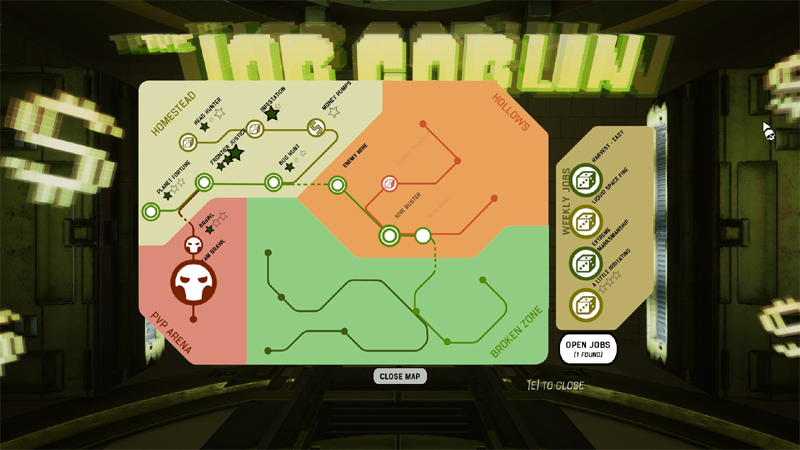
The Job Goblin gives you a huge amount of missions to enjoy. If only the side-missions were more clearly stated.
Gunheart’s latest major update added a non-VR mode of gameplay, which is cross-compatible with multiplayer in VR. Unlike most VR games with this option, non-VR in Gunheart is an excellent experience that replicates the main game almost perfectly. Free locomotion and teleportation are both included, the latter truly feeling like its own game mechanic. The game can be played, and enjoyed, for hours with a mouse and keyboard. The only change from the VR version is that, in non-VR, you can’t wield different weapons in each hand. Still, Gunheart in non-VR mode is a solid enough experience that it makes the game worth buying- even for players without a VR headset.
What would I pay for it? Gunheart is a massive, generally high-quality shooter with a lot of depth. This is one of the few VR games that I would consider “AAA-tier.” For $30, you get easily over a dozen hours of exciting content. With endless weapon customizations, countless ways to experience over 20 levels as well as weekly missions, cooperative play and non-VR mode, and addictive high-score and loot-box systems, this game will hold your interest for however long the gameplay itself stays fun to you. Although it can be frustratingly glitchy at times, the developers evidently care, frequently releasing updates that improve the experience. If Gunheart seems like a fun game that you’d enjoy, I would absolutely recommend buying it for its asking price of $30.
